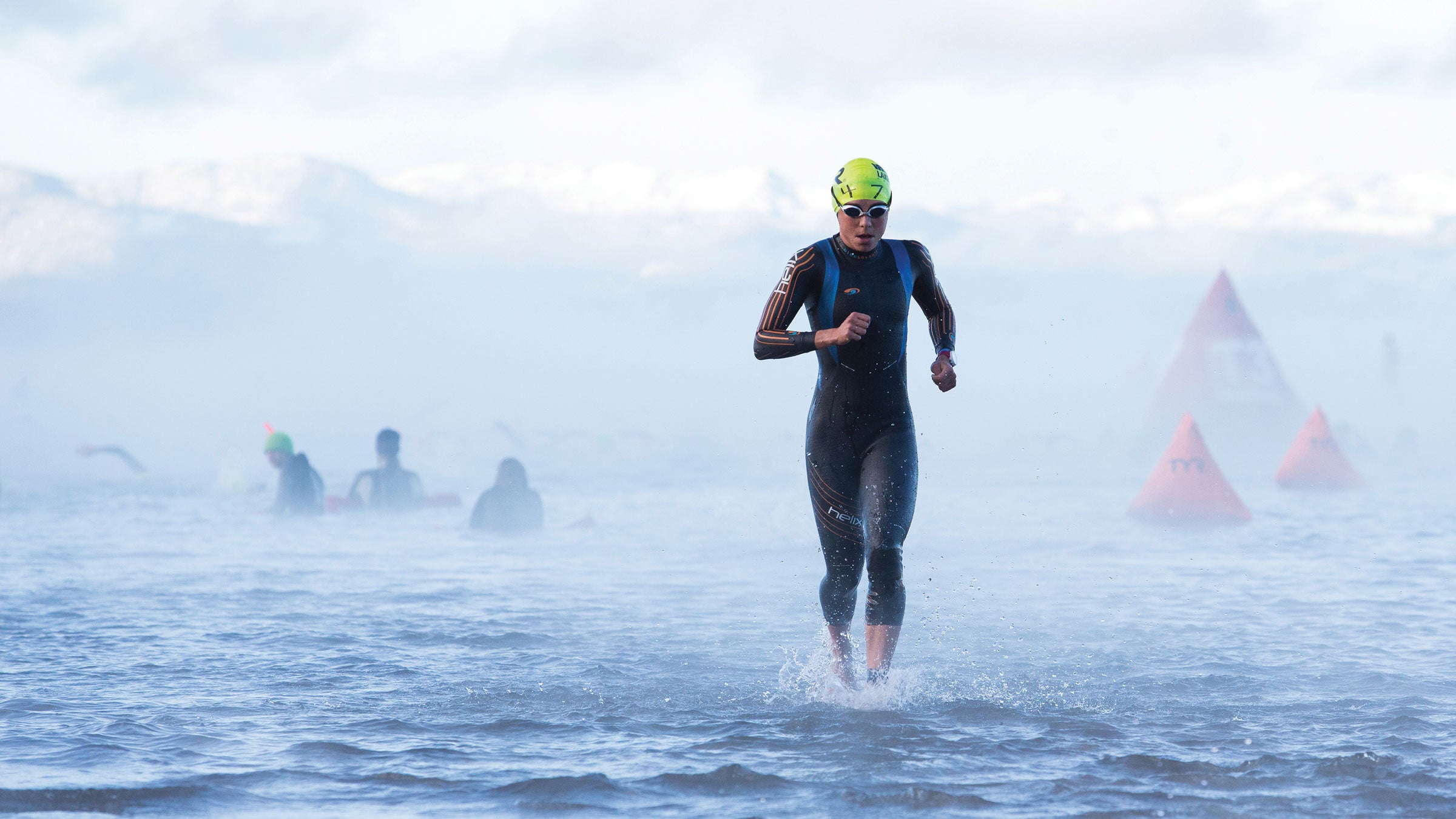Recalled: A Frigid Day at the 2013 Ironman Lake Tahoe Triathlon

Canada's Angela Naeth exits the water after a frigid swim at the 2013 Ironman Lake Tahoe triathlon. (Photo: Andrew Loehman)
Ask anyone who competed in the inaugural Ironman Lake Tahoe in 2013 about the race and they’ll surely have a tale or two to tell you about just how harrowing it was. What was touted as a race in one of the most beautiful spots in the world quickly turned to a battle of will–and a race of attrition–as athletes faced extreme conditions, including wicked winds and freezing temps. As if the course wasn’t challenging enough with its steep gradients, 6,500 feet of climbing (all set at 6,000-feet of elevation), the wicked weather threw an unwelcome wrench into race-day plans and etched the event as one of the coldest Ironmans on record.
The day before the race, snow fell as athletes descended upon the event venue for bike racking and check-in, with the winds whipping the usually placid lake into an ocean-like frenzy. The question on just about everyone’s minds was whether the swim would be cancelled given the rough conditions. But, by race morning there was no such decision: The water temperature was actually comparatively balmy 61 degrees F. The swim–and the race–was on.
While the snow storm eventually passed, temperatures remained frigid, hovering around 30 degrees F on race morning. Bundled up athletes in the transition area chipped away at icicles on their bikes, many of them questioning their decision–and their sanity–for embarking on the strenuous journey ahead.
As uncomfortable as the conditions may have been for the athletes at the swim start, the scene did present one of the most iconic images of an Ironman event: Wetsuit-clad athletes, shrouded in steam, entering the water at Kings Beach as the sun rose over the snow-capped Sierra Nevada Mountains. Once in the water, athletes struggled to stay on course as the low-lying mist clouded their vision. And once out? They were injected into the freezing air once again, although this time, soaking wet.
Race directors set up heated tents in transition where athletes could change, although the effort did little to really warm everyone up. Crowded and chaotic, one athlete remarked that the tent scene was like “a Russian bath house that got hit by a tornado.” With numb feet, frozen fingers and chattering teeth, athletes had trouble layering on bike jackets, leg warmers, and gloves. According to race stats, many athletes took more than 25 minutes in the swim-to-bike transition.
For many, the tough stuff was just getting started. The bike brought several steep climbs. Coupled with less-than-nimble fingers and the altitude, the course had a dramatic impact on bike splits. Just two athletes broke five-hours on the bike, with pro triathlete and eventual winner Chris McDonald turning in the fastest split of the day in 4:55:42 (to put that into context, weeks earlier, en route to his win in Ironman Louisville, he biked 4:29:15.). Others fared much worse: 267 athletes–12 percent of the field–either dropped out during the bike portion of the race or did not make the cut-off.
The marathon run was far from kind to those participants brave enough to attempt it. While scenic (it followed a course out of Squaw Valley and past the iconic Olympic rings), it was punctuated with punchy hills that slowed many to a walk. As the hours ticked by, the temperatures dropped back into the 30s, creating a potentially dangerous environment for the exhausted athletes. On the run, another 182 triathletes called it a day.
All told, some 21 percent of the field did not finish Ironman Lake Tahoe in 2013. The 2013 field’s average finish time of 14 hours and 6 minutes, remains among the highest in history, according to the website RunTri (the average triathlete completes an Ironman in 12 hours and 35 minutes, according to the site.)
While a popular and much-touted event, Ironman Lake Tahoe was not meant to be: The 2014 race was canceled due to wildfire smoke following the King fire, and in 2015, the race was shuttered by Ironman, citing “adverse environmental and weather conditions” which made the races “challenging to operate.” Which, if you ask anyone who raced in 2013 was quite the understatement.
“It was just tough. The altitude, the big climbs, the big descents,” said women’s winner Asa Lundstrom of Sweden, who crossed in the line in 9:58. “I had to dig real deep all the way to the end. I was just hoping I could finish.”